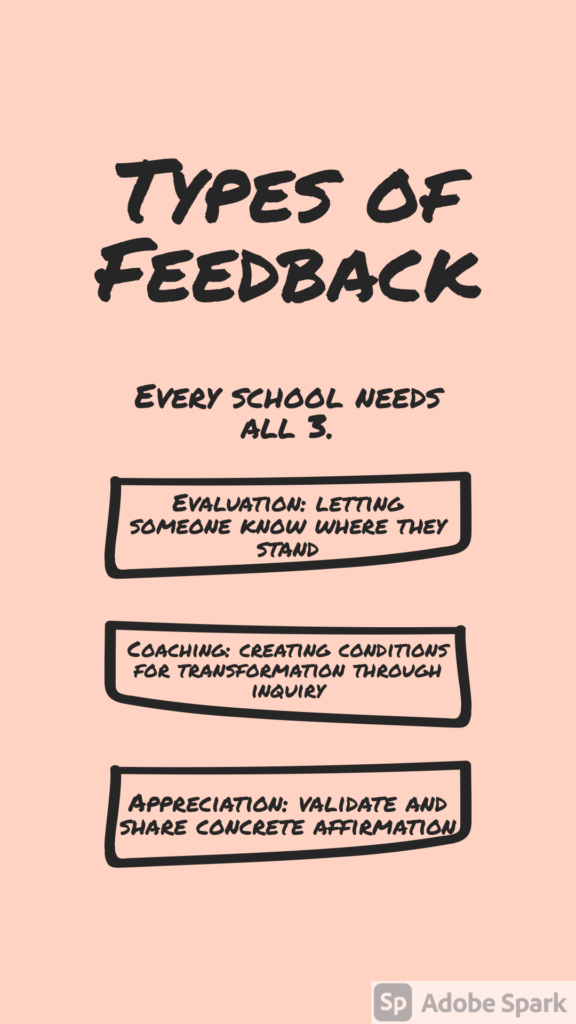The Art of Giving Meaningful Feedback
Educators pour their hearts and souls into teaching. When I was a classroom teacher I started pinning posts about classroom decor and learning activities on the first day of summer break. I kid you not. I loved what I did and I wanted to give it 100%. I think this is true of most teachers. Teachers don’t enter the profession because of the pay or the recognition, they do it because they love kids and they love learning. They spend countless hours decorating, designing engaging curriculum, and grading papers on their evenings and weekends. And while many teachers want to be the best that they can be, it is sometimes hard to open up our classrooms to outside feedback and scrutiny. I think that is because we pour so much of our soul into our craft that feedback becomes a very personal thing and being vulnerable is hard. That is why it is vital that coaches take the time to develop trust with teachers and carefully think through how they can encourage, empower, and support teachers in their professional learning.
There are 3 different types of feedback. Each is important and needed in our schools.

While Coaches can be cheerleaders and highlight the various successes happening on campus, the main type of feedback they give is aimed at helping teachers reach their goals. Grant Wiggins defines feedback as “information about how we are doing in our efforts to reach a goal” (2012). In extensive research done by John Hattie, it was found that giving formative feedback to teachers (aka offering coaching), has an effect size of .90 on student achievement (Bright Morning, 2016). If coaches can effectively offer teachers feedback, then we can have a tremendous impact on our students’ learning! So what goes into the art of giving meaningful feedback?
First, coaches need to take the time to develop trust and credibility with teachers (Bright Morning, 2016). This step should not be rushed since it is the foundation for future success. After this has been developed and nurtured, coaches can come alongside teachers and offer their support. Montini (2014) and Brown (2020) give great tips on how to support teachers emotionally and set the meeting up for success. When working with teachers make sure to sit on the same side of the table. Be mindful of your body language and start by saying we’re in this together. These steps can help a teacher feel comfortable and disarm a potentially disgruntled or nervous teacher.
After researching I compiled the following suggestions for coaches when giving feedback:
1. Ask permission
Before giving feedback ask if it is okay and explain that your intention in giving feedback is coming from a place of care and concern, and a desire to help the teacher reach their goals (Aguilar, 2013). This could sound like, “Can I share a couple of things with you that I observed that might help you address those issues you’re raising?” (Aguilar, 2013).
2. Focus on data
Instead of discussing what the teacher did well or where they struggled, focus the conversation on student data or non-judgmental observation notes. For example, noting how many students were participating during a lesson when a teacher’s goal was focused on student engagement. Wiggins (2012) argues that “Effective feedback requires that a person has a goal, takes action to achieve that goal, and then receives goal-related information about his or her actions”. So ask yourself, what is the teacher’s goal? Stay specific and focused on feedback that gives the teacher information on how they are doing reaching that goal. If you’d like to learn more about structuring coaching conversations around data, my friend Megan Heineman has a great blog post on using a third point during coaching sessions.
3. Less is more
Elena Aguilar (2013) encourages coaches to keep critical feedback to one or two key points. We don’t want to overwhelm teachers with every bulleted point on our notes. Begin by affirming something the teacher did well and then give feedback related to their personal goal. Effective feedback is concrete and specific (Wiggins, 2012).
4. Plan next steps
After you’ve shared feedback with the teacher, invite them to share their thoughts and/or feelings. Does the teacher become defensive, embarrassed, curious, or relieved? Aguilar stresses how important it is to help teachers process these emotions so that they are ready to take the next step (2013). It’s important to ask “what’s next?” and “how can I support you?”. By asking these questions, the coach is putting the teacher into the driver’s seat. You’re not ending on a negative note, but a positive one of how you can proactively move forward.
5. Follow up!
Too often we give feedback and then never return to see if it is being implemented (Bright Morning, 2016). Teachers need ongoing support, encouragement, and more feedback. By checking in with teachers we encourage this iterative cycle of professional learning where we try something out, reflect on the outcome, tweak it and then try again. Coaches can help by giving formative feedback that provides teachers with the opportunity to reshape their performance to achieve their personal goals (Wiggins, 2012).
What practices do you think are essential when giving feedback? I’d love to hear your thoughts from either a place of receiving or giving feedback to others.
Works Cited
Aguilar, Elena. (2013, March 6). Giving Feedback. Education Week. https://www.edweek.org/education/opinion-giving-feedback/2013/03
Aguilar, Elena. (2018). Receiving and Giving Feedback. Bright Morning. https://brightmorningteam.com/wp-content/uploads/2019/09/Giving-and-Receiving-Feedback.pdf
Bright Morning. (2016, February 15). Common Mistakes When Giving Feedback. Bright Morning. https://brightmorningteam.com/2016/02/common-mistakes-when-giving-feedback/
Brown, Brené. (2020). Daring Greatly: Engaged Feedback Checklist. Retrieved from https://brenebrown.com/downloads/
Montini, Laura. (2014, October 16). 2 Things Great Leaders Do When They Give Feedback. Inc. https://www.inc.com/laura-montini/brene-brown-why-great-feedback-can-t-be-scripted.html
Wiggins, Grant. (2012, September). Seven Keys to Effective Feedback. ASCD. http://www.ascd.org/publications/educational-leadership/sept12/vol70/num01/Seven-Keys-to-Effective-Feedback.aspx




5 Comments
Megan
Great, easy to follow ideas for providing meaningful feedback. I know this technically wasn’t one of the 5 ideas but I really liked what you shared about sitting on the same side as the teacher. I agree that this helps make everyone feel more comfortable. I always purposefully moved chairs and set things up so that my mentee and I were sitting next to each other. Thanks for sharing and the reminder that follow-up is just as important as the initial feedback.
Pingback:
Sarah
I love how straightforward this post is. It lists how to be successful with meaningful feedback with going into mundane details. I appreciate the question you pose towards the beginning about being able to increase student achievement if we focus on increasing the effectiveness of our feedback. This was a wonderful post, thank you for sharing!
Joseph Halbert
I loved #5 in particular – any pointers on how to remind oneself to follow up and best ways to go about it? I’m imagining something as simple as a one-sentence email and a calendar reminder, but I’m sure there are more holistic ways to go about it?
Thanks!
Joseph
admin
Thanks for the comment, Joseph! Sometimes the simpler the better. I think calendar reminders and quick emails are great ways to touch base with teachers. Another idea would be to use Weekly Pulse Checks with your staff. Dr. Nathan Lang-Raad talks about them in a webinar hosted by ISTE titled “Creating Authentic Learning Experiences in a Distance/Blended Learning Environment”. He uses these Weekly Pulse Checks to stay in communication with teachers between meetings. Check it out here: https://iste.zoom.us/rec/play/XkHdcTnQEzLWz-fpE6wGdOk42ko7ys9VIkRqDBgY_FOeomH_5WHbQ7BdG-iPRbRFqmoAEYOFuaEZfaA-.GncHrCs_8Sn45iU9?startTime=1612288859000&_x_zm_rtaid=LLU0BbjwSDeavwVG6mo4ow.1615303037596.c72ddb390296781677b8277a26756b39&_x_zm_rhtaid=851